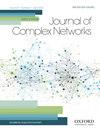双重异质的生成超图模型
IF 1.5
4区 数学
Q2 MATHEMATICS, INTERDISCIPLINARY APPLICATIONS
引用次数: 0
摘要
虽然网络科学已成为研究复杂系统不可或缺的工具,但传统的成对链接往往在正确描述高阶交互作用方面显示出局限性。超图(每条边可以连接两个以上节点)因此成为网络科学的新范式。然而,我们仍然缺乏将网络增长和超边缘扩展联系起来的模型,而这两者在现实世界中都是可以观察到的。在这里,我们提出了一种生成超图模型,在节点和超边形成中都采用了优先附着机制。该模型可以产生双异质性,在超度和超边大小上都表现出无标度分布。我们提供了一种均场处理方法,给出了两个缩放指数的表达式,与数值模拟结果一致。我们的模型可能有助于理解呈现两种异质性的网络系统,并促进对其复杂动力学的研究。本文章由计算机程序翻译,如有差异,请以英文原文为准。
A generative hypergraph model for double heterogeneity
While network science has become an indispensable tool for studying complex systems, the conventional use of pairwise links often shows limitations in describing high-order interactions properly. Hypergraphs, where each edge can connect more than two nodes, have thus become a new paradigm in network science. Yet, we are still in lack of models linking network growth and hyperedge expansion, both of which are commonly observable in the real world. Here, we propose a generative hypergraph model by employing the preferential attachment mechanism in both nodes and hyperedge formation. The model can produce bi-heterogeneity, exhibiting scale-free distributions in both hyperdegree and hyperedge size. We provide a mean-field treatment that gives the expression of the two scaling exponents, which agree with the numerical simulations. Our model may help to understand the networked systems showing both types of heterogeneity and facilitate the study of complex dynamics thereon.
求助全文
通过发布文献求助,成功后即可免费获取论文全文。
去求助
来源期刊

Journal of complex networks
MATHEMATICS, INTERDISCIPLINARY APPLICATIONS-
CiteScore
4.20
自引率
9.50%
发文量
40
期刊介绍:
Journal of Complex Networks publishes original articles and reviews with a significant contribution to the analysis and understanding of complex networks and its applications in diverse fields. Complex networks are loosely defined as networks with nontrivial topology and dynamics, which appear as the skeletons of complex systems in the real-world. The journal covers everything from the basic mathematical, physical and computational principles needed for studying complex networks to their applications leading to predictive models in molecular, biological, ecological, informational, engineering, social, technological and other systems. It includes, but is not limited to, the following topics: - Mathematical and numerical analysis of networks - Network theory and computer sciences - Structural analysis of networks - Dynamics on networks - Physical models on networks - Networks and epidemiology - Social, socio-economic and political networks - Ecological networks - Technological and infrastructural networks - Brain and tissue networks - Biological and molecular networks - Spatial networks - Techno-social networks i.e. online social networks, social networking sites, social media - Other applications of networks - Evolving networks - Multilayer networks - Game theory on networks - Biomedicine related networks - Animal social networks - Climate networks - Cognitive, language and informational network
 求助内容:
求助内容: 应助结果提醒方式:
应助结果提醒方式:


